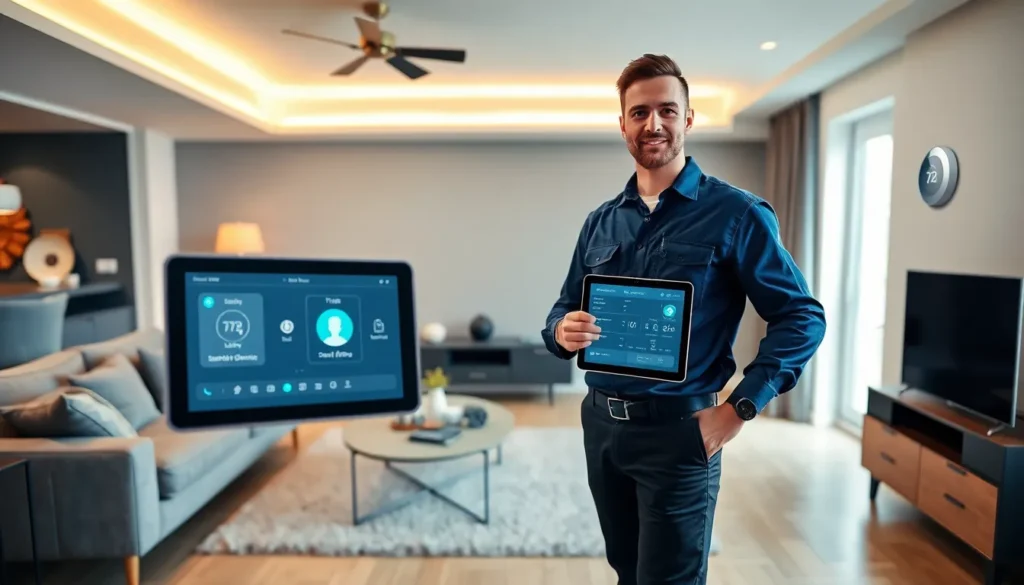Imagine walking into your home and having the lights adjust, the thermostat set to the perfect temperature, and your favorite playlist start playing, all without lifting a finger. Welcome to the world of smart home systems. These wonders of technology not only make life easier but can also leave you feeling like you’ve stepped into the future. In this text, we’ll explore everything you need to know about smart home system installation, helping you transition from a technology novice to a savvy smart home guru. Let’s immerse.
Table of Contents
ToggleUnderstanding Smart Home Systems

Smart home systems integrate various devices to create a connected living environment. These systems allow users to control everything from lighting to security from a single point, usually through a smartphone app or a voice assistant. The core of smart home technology revolves around home automation, remote control, and efficient energy management.
Smart Home Components
Key components of a smart home include:
- Smart Lighting: Adjust brightness and color using an app.
- Smart Thermostats: Automatically adjust heating and cooling based on usage patterns.
- Smart Security Systems: Include cameras and locks that can be controlled remotely.
- Smart Speakers: Assist with voice commands to control home systems.
- Smart Appliances: Refrigerators, ovens, and washing machines that communicate with users.
The beauty of a smart home is the ability to tailor it to individual needs and preferences, making life simpler and more efficient.
Benefits of Smart Home Systems
Installing a smart home system comes with a plethora of advantages. Firstly, convenience reigns, imagine controlling every device from one app. Secondly, energy efficiency is a significant game changer: smart thermostats can learn habits and optimize heating and cooling, potentially lowering energy bills.
Enhanced Security
These systems often come with enhanced security features. Homeowners can receive instant alerts on their smartphones if unusual activity is detected, giving them peace of mind.
Improved Comfort
Smart home systems also enhance comfort. It’s easier to set the mood for a dinner party with smart lighting or start a movie night with a voice command that dims the lights and turns on the TV. Overall, the seamless integration of various technologies creates a highly personalized living experience.
Choosing the Right Smart Home Devices
With a vast array of smart devices available, choosing the right ones can be daunting. Consider these factors when selecting devices:
- Compatibility: Ensure devices work together and with your existing ecosystem.
- User-Friendliness: Opt for devices that have intuitive setups and interfaces.
- Brand Reputation: Trusted brands often have better support and durability.
- Features: Choose devices that offer features that genuinely improve your lifestyle.
Popular Smart Home Devices
Some popular categories of devices include:
- Smart lights (Philips Hue)
- Smart locks (August Smart Lock)
- Smart cameras (Ring, Nest)
- Smart speakers (Amazon Echo, Google Nest)
Carefully selecting compatible devices can lay a solid foundation for a fully integrated smart home.
Steps for Installing a Smart Home System
Successfully installing a smart home system involves several straightforward steps:
- Plan Your System: Determine which areas you want to automate and the devices needed.
- Check Compatibility: Ensure all devices can communicate with your chosen platform (like Google Home or Amazon Alexa).
- Install Devices: Follow manufacturer instructions for setting up devices. This can include plugging them in, connecting to Wi-Fi, and updating firmware when necessary.
- Testing: Before finalizing the installation, test each device for proper functionality.
- Create Routines and Scenes: Use the app to set preferences, like creating “movie night” scenes that adjust the lighting and audio.
Common Challenges in Smart Home Installation
While setting up a smart home system is a rewarding venture, it’s not without its challenges. Common issues include:
- Wi-Fi Connectivity: Many smart devices rely on strong Wi-Fi signals. Poor connections can lead to frustrations.
- Compatibility Issues: Not all devices play well together. Ensure your devices are compatible with your hub or ecosystem.
- Overwhelming Choices: With so many devices on the market, the selection process can be intimidating and convoluted.
- User Error: Simple mistakes can complicate setups. Always refer to manuals or manufacturer support.
Maintenance and Troubleshooting Tips
Keeping a smart home system running smoothly requires routine maintenance. Here are some handy tips:
- Regular Updates: Ensure all devices and apps are updated to the latest versions to maintain security and features.
- Reboot Devices: Like all technology, sometimes a simple reboot can solve connectivity issues.
- Network Management: Use a reliable router with the latest standards to handle more devices.
- Regular Testing: Check the functionality of all devices periodically to ensure they are working as intended.
Future of Smart Home Technology
The future of smart home technology is thriving and evolving. We can expect to see advancements such as:
- Increased Interoperability: Devices from different manufacturers will increasingly work together more seamlessly.
- Artificial Intelligence (AI) Integration: Enhanced AI capabilities will make devices smarter, learning user behaviors and preferences.
- Sustainability Features: Smart homes will increasingly focus on energy efficiency and sustainable energy sources.
- Health Monitoring: Anticipate devices that monitor indoor air quality and even health metrics, contributing to a safer living environment.
The integration of smart home technologies is set to make homes not just smarter but also more connected and responsive.






